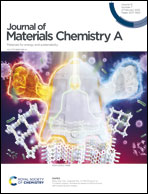Electroluminescence and photocatalytic hydrogen evolution of S,N co-doped graphene oxide quantum dots
Abstract
Heteroatom-doped graphene quantum dots (GQDs) can change the optical, chemical, electrical, and optoelectrical properties of materials and diversify their functions. GQDs can be used in a wide range of applications, including in fluorescent agents, light-emitting diodes, bioimaging, solar cells, optoelectronic detectors, photocatalysts, etc. In this article, we describe the synthesis of S and N co-doped graphene oxide quantum dots (S,N-GOQDs) with stable electroluminescence, photoluminescence, and photocatalytic properties and their optoelectrical applications as an emitter of a light-emitting diode device in electro-optical energy conversion and as a photocatalyst for hydrogen evolution in photo-chemical energy conversion. The synthesized S,N-GOQDs show a high yield and excitation-independent emission. The maximum excitation wavelength and emission wavelength are 371 and 447 nm, respectively; the quantum yield is 61% when excited at 371 nm; and the emission half-width is 40 nm. A bright blue emission with a luminance exceeding 1341 cd m−2 was achieved at 6 V, thus proving the potential of S,N-GOQDs as an emitter in electroluminescence applications. For photocatalytic hydrogen evolution, the system consists of a 0.1 mg mL−1 catalyst in pure water or TEA (1.43 M) + 80% EtOH aqueous solution. In pure water, high reaction rates of 3.001 mol h−1 g−1 were obtained under direct sunlight. In the TEA (1.43 M) + 80% EtOH aqueous solution, an unprecedented efficiency of 71 mmol h−1 g−1 and 6.138 mol h−1 g−1 was obtained under a 500 W Xe lamp and direct sunlight, respectively.



 Please wait while we load your content...
Please wait while we load your content...